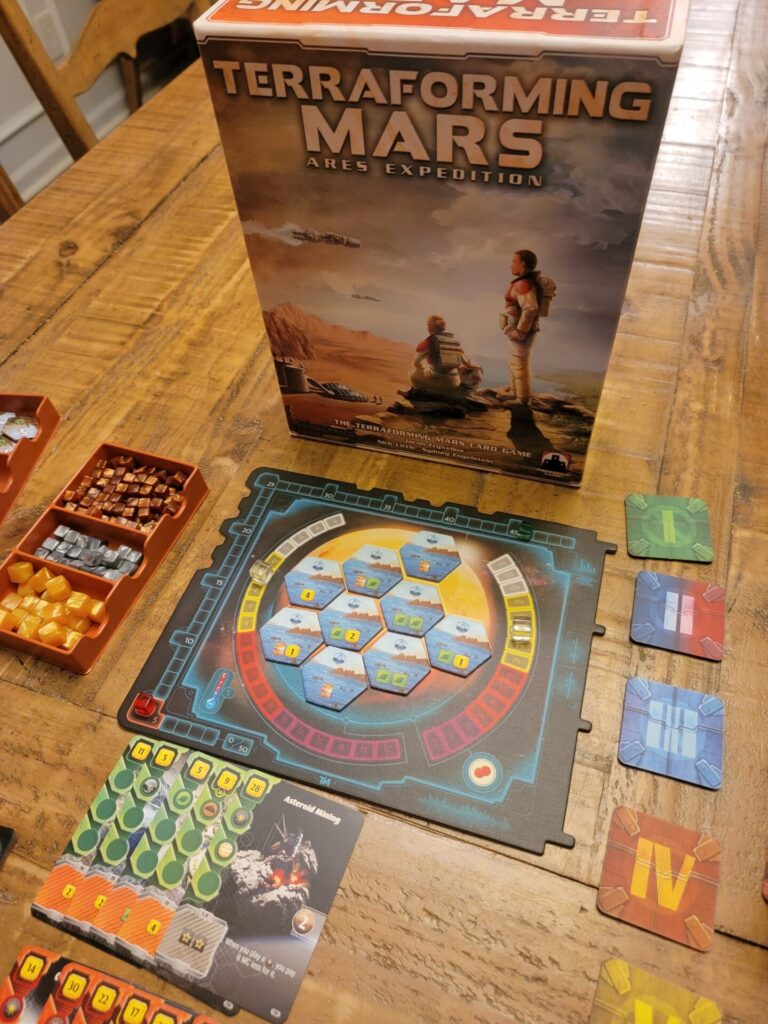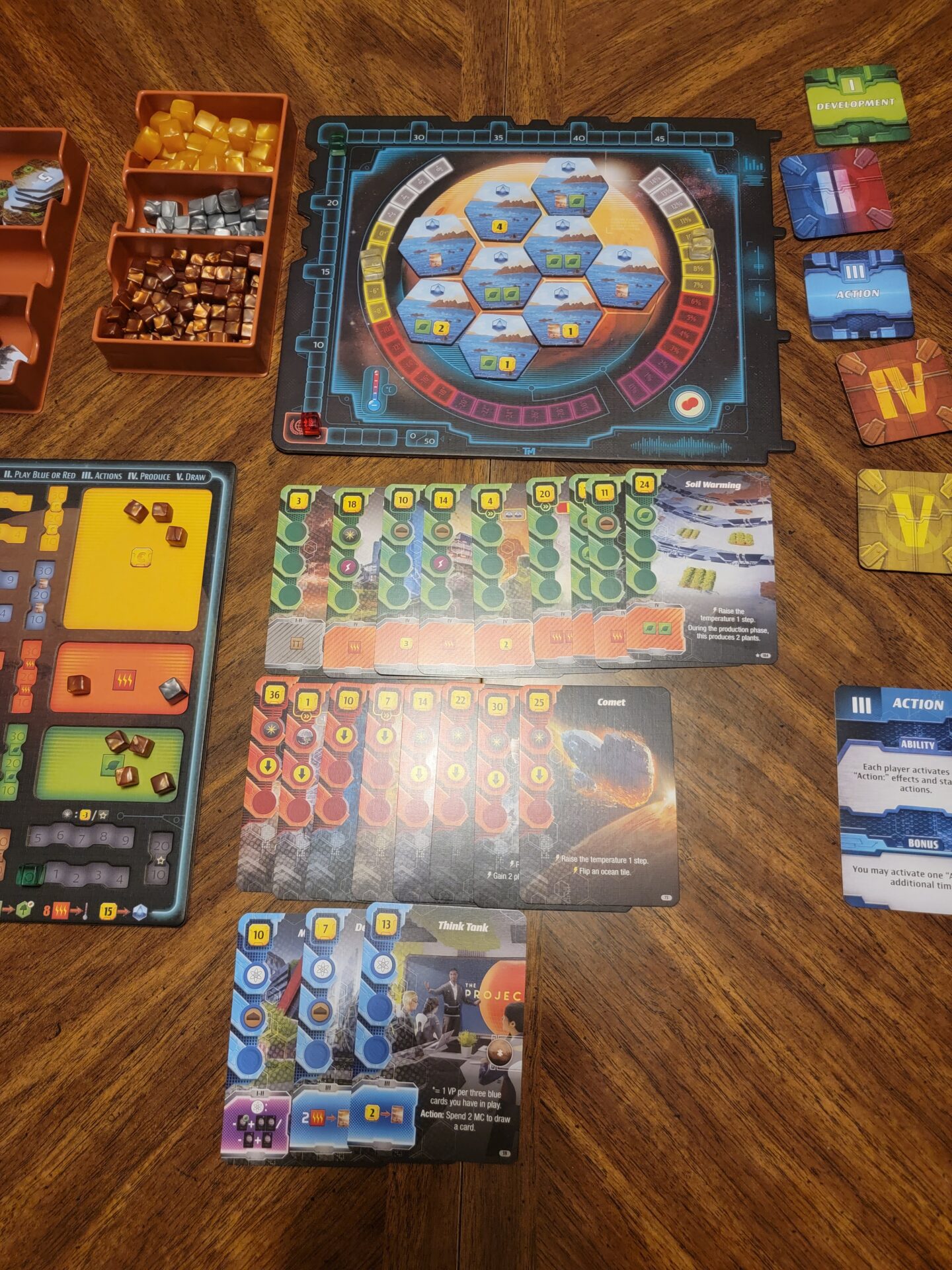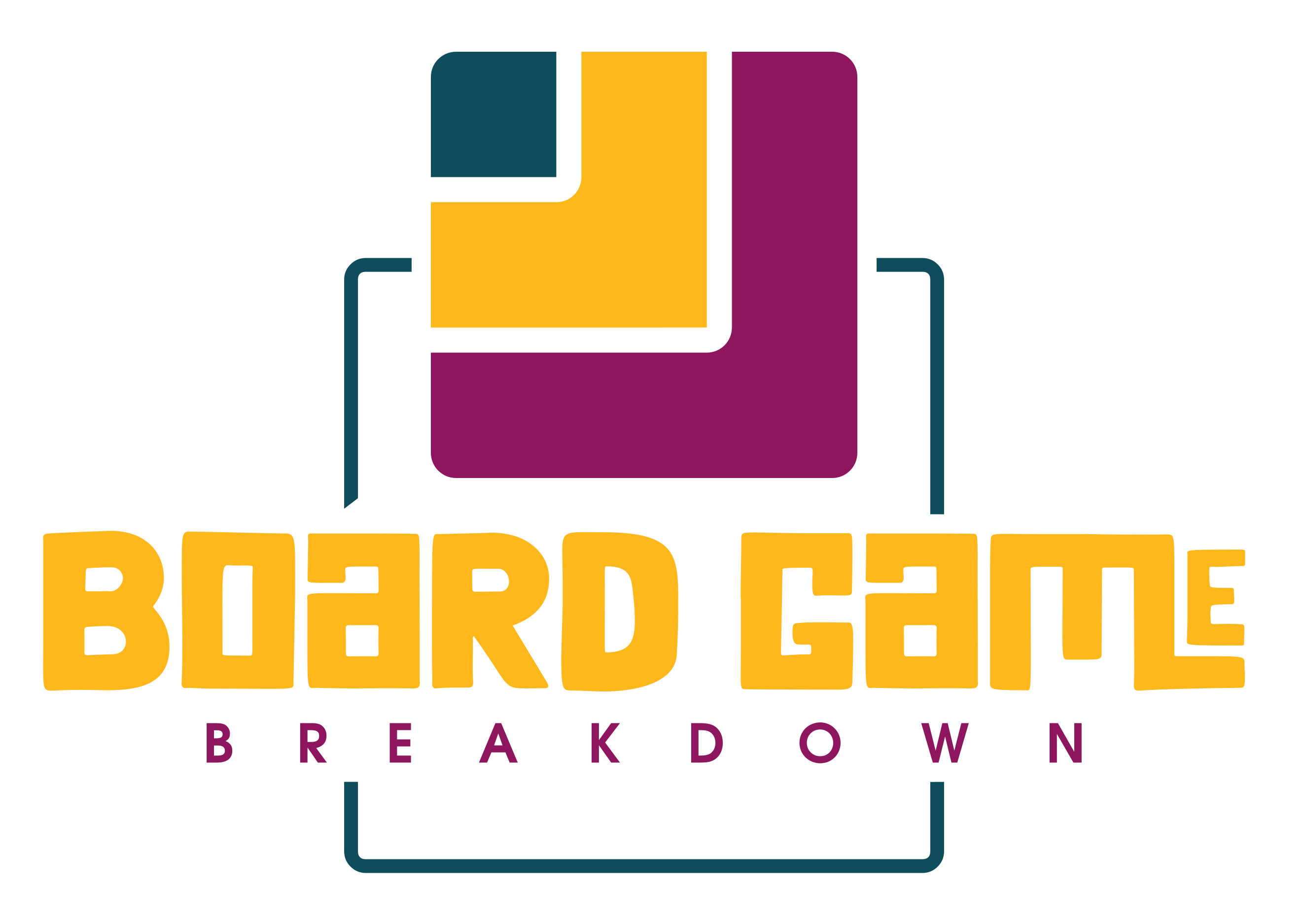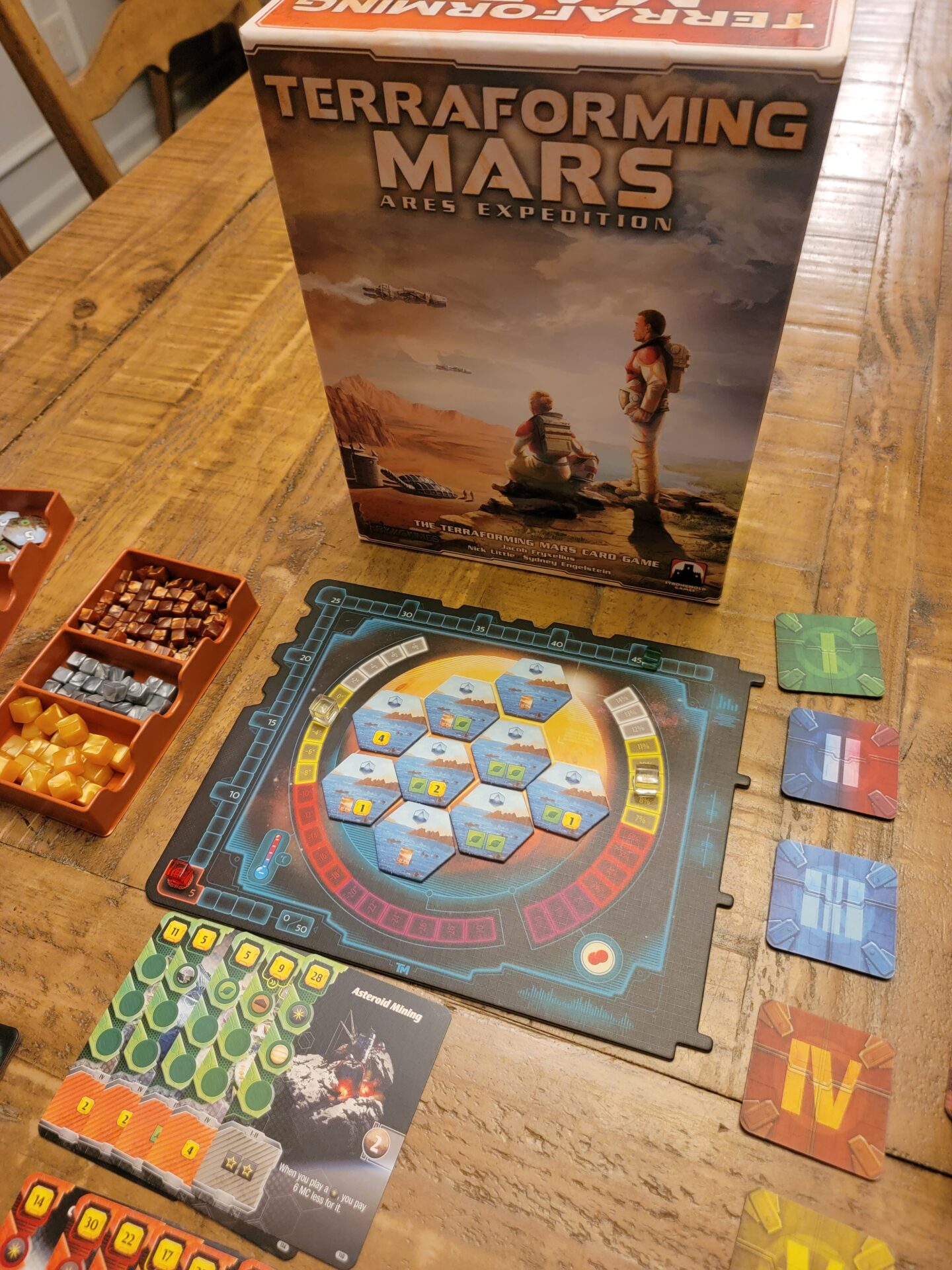
Name: Terraforming Mars – Ares Expedition
Year of Release: 2021
Player Count: 1 – 4
Playing Time: 45 – 150 Minutes
Designer: Sydney Engelstein, Jacob Fryxelius, & Nick Little
Publisher: Stronghold Games
Primary Mechanisms: Hand Management, Simultaneous Action Selection, Income
Weight (According to BGG.com): 2.91
Overview
The original Terraforming Mars came out in 2016, around 7 years ago from the time of this writing. It has been a mainstay on the top 100 list on BoardGameGeek, currently residing at rank #6 overall. In 2017, it was nominated for the Kennerspiel des Jahres award for Best Strategy Game of the Year. Additionally, it actually won the Best Family/Adult Game at the 2017 Deutsche Spiele Preis. Even with all of these accolades and constantly seeing this game mentioned year after year, I’ve never had any inclination to play it. The theme seemed like something done a hundred other times and the weight definitely made me think that my primary playing partner wouldn’t like it. So, I stayed away from it.
Enter Terraforming Mars: Ares Expedition in 2021. Again, nothing too compelling for me but there was one difference, this game was routinely in stock at big box stores near me, meaning that every now and then, I would pick up the box and glance over it and wonder, “is this version something I would like?” The answer finally became a “yes” when Barnes & Noble featured all games at 50% off recently and they had one more copy of Terraforming Mars: Ares Expedition. At the low cost of $26, it wouldn’t be that huge of a deal if I didn’t enjoy it right?
Fast forward a few weeks, and a few plays later, and I really like this game. I bought it primarily to play with my wife but I was blown away by the official solo mode packaged in the game. I’m assuming that most write-up and reviews out there will focus on the game from a multiplayer perspective, so I’m going to focus on Ares Expedition from the perspective of a solo gamer. Read on to see how a solo gamer fares at becoming a CEO of a corporation, looking to turn Mars into a place for business and prosperity.
Rulebook & Components
Players will receive an informative 20-page rulebook with Terraforming Mars: Ares Expedition. The first half of it is dedicated to explaining the layout of various boards and the cards that players will use to power their engine. The second half is primarily focused on the five actions and how they work within the context of the game. The solo portion of the rulebook only takes up a lone page but don’t worry, you won’t need any more than that. This is mainly due to the solo game being almost identical to a multiplayer game. I’ve rarely had to go back to the rulebook for any explanations and the few times I did, finding the answer was simple so that’s really the best compliment a rulebook can get.
Though the game is marketed as “the Terraforming Mars card game,” there are a few non-card components that come in the box. First, let’s talk about the individual Player Boards. These boards are given out to each player and are used as a means to track Production of resources throughout the games. One nice touch to these board is that each resource track is slightly depressed, creating a small indention for the cube to fit snugly into. Another pleasant quality is that the board also acts as a reminder of the Phases as well as the Standard Actions one might take, eliminating the need for an additional player aid that so many modern games love to throw in.
The other board that players will get is the Mars Board, used to track the three terraforming statuses of the planet as well as the Terraforming Rating for each player. Now, one might think that with this board also containing tracks that small cubes are going to have to work their way up and down on, it too might include that wonderful quality of life decision to imprint the tracks slightly for the cubes to rest in. Too bad, so sad. This board just contains the normal old, printed tracks and I have to say, on more than one occasion, the cubes tracking Temperature or Oxygen levels have shifted or not been placed in the right spot. With such a tight window to meet the win conditions in this game, this can be a real killer.
The cards themselves are colorful and laid out in a way that makes sense, at least to a player that has experience with modern board gaming cards. I can imagine a newer player feeling a bit overwhelmed, but each card has text on it, specifying what it does exactly so there isn’t too much need to reminder every single little icon. The balance of the components (cubes and a few tiles) are strictly fine, but I will give a shoutout to the two plastic trays that ship with the game, as they make setup and teardown a breeze.
Speaking of setup…
Setup and Gameplay

From the previous section focusing on the components, you can probably tell that setup is going to be a cinch. The bulk of the time is going to be spent putting your cubes in the small “0” slots in each of the resource trackers (Mega Credits (MC), Cards, Heat, Plants, Steel and Titanium.) You’ll then draw one of the 12 Corporation Cards, making changes to your Production Board as needed. You also have to set out a few cubes on the Mars Board and put out the nine Ocean Tiles into their printed hexagon spaces. You will grab a set of five Phase Cards for yourself and deal out four Project Cards to create your starting hand.
The main difference in solo setup is that you don’t really have an opponent, as you are racing the clock to fully terraform Mars. You will select a color to represent the round tracker and place it on spot one of the Terraforming Rating (TR) track around the outside of the Mars Board. You also need to grab an additional set of five Phase Cards to act as a dummy hand. Though the “opponent” will never be taking actions or gaining points, these other Phase Cards still allow for you to typically resolve two actions on your turn.
Before we move onto the gameplay talk, be fully aware that the five Phases seem completely ripped from the pages of Race for the Galaxy. So, if you have any understanding of that game, this section will make a lot of sense. It is so similar, when reading the rulebook, I had to stop and look at who designed the game, wondering if the designer of RftG had anything to do with TM:AE.
The bulk of the gameplay is going to revolve around choosing one of the five Phase Cards. In the solo game, you will choose one and place it face-down and then pull the top Phase Card off of the dummy deck. Once they are both flipped, this will tell you which two Phases you will activate this round. The Phase selected allows a player to do the following:
- Play cards from their hand (Development and Construction)
- Trigger card actions or standard actions (Action)
- Gain more resources based on your production tracks and your TR (Production)
- Increase the number of cards in your hand (Research)
The twist with the Phases is that if the solo player is the one to have actually chosen the Phase (as opposed to it being played randomly from the dummy hand), a Bonus action is activated. This might range from getting to play a card at a discount to gaining more Mega Credits or even getting to trigger an additional Action on a card. So, what’s the point of actually doing these Phases?
Hopefully your selection of Phases will help you to efficiently build an engine out of your cards, enabling you to terraform Mars. What exactly is “terraforming” Mars? In order to fully terraform Mars, three goals must be met: the Temperature track must increase all the way to the top; the Oxygen track must increase all the way to the top; all nine Ocean Tiles have to be flipped to the ocean side. The majority of these goals will be met through a combination of Standard Actions (such as spending eight Heat to raise the Temperature a level) as well as playing cards that give an instant effect to help with these. The solo mode also gives you a choice of difficulty level, enabling an increase to the two tracks after each round to help the player out.
A round lasts five Phases, so basically once the dummy hand has cycled through all of its Phase Cards. They are shuffled and the round tracker is moved up one space. In the fifth and last round, the player is given the ability to choose the order that the dummy hand will be played so that there is a little more control over the order of actions. This is a wonderful addition as most of my solo plays have gone down to the wire and I really needed this boost in the end to make sure my plans worked out.
If at the end of the fifth round, the three goals are not met, the player automatically loses. If they have been met, then you record what your TR (essentially the game’s Victory Points) is and always attempt to beat out your high score. While I enjoy playing this game with multiple players, the tension is definitely ratcheted up in the solo game. Knowing I only have a finite time to build my engine and get things cracking is a bit of a rush, so much that if I lose by a small margin, I typically set the game up again so that I can play again immediately. It is quite the addicting solo game.

Conclusion
I’ve really enjoyed my time with Terraforming Mars: Ares Expedition and wish I hadn’t slept on it as long as I did. I’m still not sure if I would like the original version as I really like the efficiency of each turn in Ares Expedition. Everything feels streamlined and polished, and I really like that. While I probably wouldn’t choose to play this multiplayer over something such as Ark Nova, I definitely recommend the solo game as a fairly rapid, tense, and most importantly, fun, experience.
Rating
Ratings are based on 5 main criteria: rulebook, setup, components, art & graphic design, and gameplay. The first 4 criteria are rated 1 to 5 and the gameplay is rated 1 to 10. These scores culminate in an “overall satisfaction” score that is rated from 1 to 10. If the reviewed game has both a solo and multiplayer mode, I have assigned scores separately to give context to which mode we enjoy more.
Links
As an Amazon Associate I earn from qualifying purchases.
Amazon: Terraforming Mars – Ares Expedition board game

